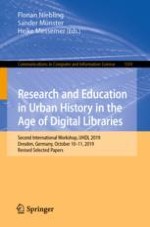2021 | Book
Research and Education in Urban History in the Age of Digital Libraries
Second International Workshop, UHDL 2019, Dresden, Germany, October 10–11, 2019, Revised Selected Papers
Editors: Florian Niebling, Sander Münster, Heike Messemer
Publisher: Springer International Publishing
Book Series : Communications in Computer and Information Science
